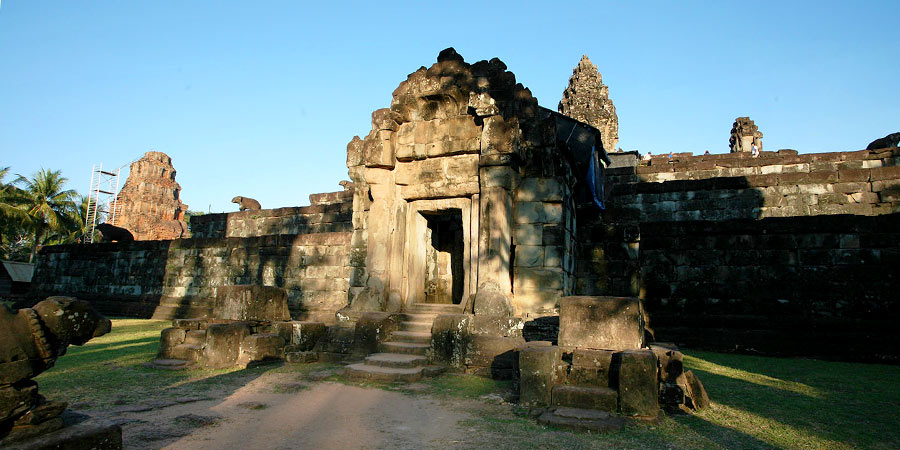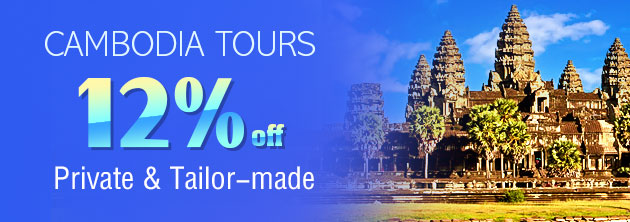Roluos Group of Temples
The small town of Roluos in Cambodia was once the seat of power of the mighty Angkor Empire. Back then, it was known as the city of Hariharalaya, the capital of the Angkor Kingdom. Today, very little remains of the town’s glory days. However, the little that is remaining makes for some fascinating explorations.Three temples, Bakong, Preah Ko and Lolei, make up the Roluos Group of temples, architectural wonders from many centuries ago. Even though Cambodian tourism is centered on the Angkor group of temples, these temples are absolutely as worthy of your attention as the Angkor temples are.
So let’s take a look at all the amazing things that the Roluos Group of Temples have to offer.
1. Architectural Brilliance of Bakong Temple
History
The most famous temple in the Roluos Group is Bakong from the 9th century and it’s not surprising once you reach the temple and feast your eyes on the temple’s architectural magnificence. Archaeologists and conservators found Bakong in ruins in the 1930s but were quick to notice the impressive nature of the temple’s architecture. Today, the temple that you will see at Bakong is no more than a shadow of its former self. However, it can still be an overwhelming site.

Bakong Temple
|
Similarities with Angkor Wat & Borobudur
Featuring architectural similarities to the main Angkor Wat temple, Bakong’s sandstone construction will leave you in awe. Even though restorers had to put the temple back together using brick, it still makes for a stunning spectacle, as it has several statues and carving fragments to this day.Bakong also has numerous similarities to one of its contemporary temples; the Borobudur Temple in Java. Built in the same century, Java’s Borobudur Temple is hailed as the largest Buddhist temple in the world.
So, if you are planning to visit the Roluos Group of temples, kick things off with explorations at Bakong Temple.
Read More: Angkor Wat Architecture
2. Next Up: Preah Ko
While you may find Preah Ko a lot less grand than Bakong in the Roluos Group of temples, there’s a reason why it is locally more revered than Bakong; it was ancient Hariharalaya’s first temple.History
The temple, built most probably in 879 AD, dates back to the days when King Indravarman I was the ruler of the Angkor Empire. Built in homage to Lord Shiva and also to the members of King Indravarman I’s family, the temple has lost most of its original structure with time. However, it’s still a popular attraction among the Roluos Group of temples for its intricate carvings and sculptures.

Preah Ko
|
Great Carvings & Sculptures
Some of the temple’s highlights are lion statues that welcome visitors in front of the platform, carvings of a monster called Kala towards the eastern entrance, and sculptures of female Devatas on the second rows of the temple’s sanctuaries.3. Finish Things Off with Lolei Temple
While a lot of people may tell you about Prasat Prei Monti temple, the fourth in the Roluos Group, you should give Lolei Temple a miss as it is an extremely small temple.History
The last of the temples to be built in the Roluos Group, Lolei Temple was built in the late 8th century under the rule of King Yasovarman I. It was yet another temple of the Angkor Empire that was built in dedication to Shiva and the royal family. Archaeologists and conservators consider the temple to be one of ancient Angkor’s first island temples. While several other island temples were constructed after the turn of the century, very few existed in Angkor before the construction of the Lolei Temple.

Lolei Temple
|
Excellent Brick Temple Towers
The temple stood slightly north-of-center in a water reservoir known as the Indratataka Baray, which went dry several centuries ago. It consists of four temple towers featuring excellent brick construction, with each tower dedicated to King Yasovarman I’s mother, father, grandfather and grandmother.Praiseworthy Carvings on Myths
The carvings of Devatas; Indra riding Airavata, his elephant mount; multi-headed snakes; and makaras, monsters from Hindu mythology, are the standout architectural elements of this temple.How to Reach Roluos Group of Temples?
The town of Roluos is approximately 13 km (8.1 miles) from the city of Siem Reap.Tuk-tuks and private taxis are readily available in Siem Reap, with tuk-tuk tours typically charging $15 USD for a trip to the Roluos Group of temples and a return trip to Siem Reap. It typically takes 10 – 20 minutes to cover the 2.3 km (1.4 mi) distance and tuk-tuks and taxis typically charge $15 USD for a full tour of the Roluos Group.
If you are heading out on your own with a rented bicycle or motorbike, then you can reach the Roluos Group of Temples via two routes. Motorbike rentals start from $10 USD per day while bicycle rentals start from $2 USD per day.
• The first route is the most-widely used and requires travelers to go towards Phnom Penh on National Road 6. Skip the turning for the Bakong Commune Hall and take the second turning on the left.
• The second route is longer but is preferred by solo bikers as it is less congested compared to the former route. For this route, head out of Siem Reap using Road 60 and take a left once you cross Booyoung Country Club.
Notes: Tuk-tuks and private taxis may charge inordinately high prices during the peak tourist season. If you don’t want to get ripped off, you should tell your hotel owner to bargain on your behalf to get you a good deal.
The Roluos Group of temples is waiting to be explored. So awaken the adventure enthusiast in you and explore the ruins of ancient Angkor in Cambodia.

